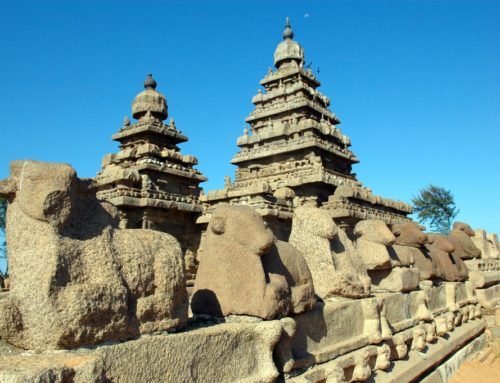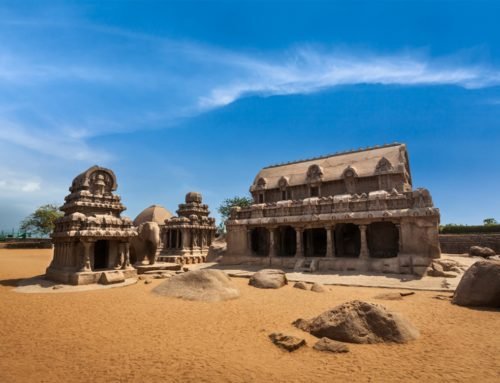Overview
- Main Attractions: Shore Temple, Pancha Rathas, Arjuna’s Penance
- Best Time to Visit: Late October to early March
- Local Specialty: Temples
- Travelled By: Train, private car, foot
- Cost: $$
- Duration of Stay: 2 days
- Location: Tamil Nadu, India
Author Reviews[display_rating_item_results rating_form_id=”4″ rating_entry_ids=”1″ show_category_filter=”false” show_options=”true” result_type=”star_rating” preserve_max_rating=”true” show_title=”false” show_count=”false” ]
Total Rating: [display_rating_result rating_form_id=”4″ show_count=”false” show_rich_snippets=true] [accordions load=”1″] [accordion title=”User Reviews” last] [display_rating_item_results rating_form_id=”5″ show_options=”true” result_type=”star_rating” preserve_max_rating=”true” show_title=”false” show_count=”true” show_rich_snippets=true] [/accordion] [accordion title=”Add Review”][display_rating_form show_email_input=”true” show_comment_textarea=”true” show_name_input=”true” rating_form_id=”5″] [/accordion] [/accordions]
Summary
Only two hours from Chennai, Mahabalipuram (Mamallapuram) is a great detour to see the world heritage temples and bas-reliefs from the 7th century. We spent two days here and there is so much to see and do. Our favourite attractions were the Shore Temple, Pancha Rathas (Five Rathas) and Arjuna’s Penance. If you can time your visit, the Mahabalipuram Dance Festival (Dec-Jan) should not be missed.
Mahabalipuram: Our Experience
22nd December, 2013 (Day 1)
From Kanyakumari it had been a very long journey to Mahabalipuram. We had boarded a train in Kanyakumari at 5:20 pm the day before and arrived into Chennai at 6:50 am this morning. From here we had plans to take a bus to Mahabalipuram, but, as luck would have it, we made friends with a lady in our train carriage who requested her friend to drop us to Mahabalipuram as they were living nearby. So, along with their family of four (father, mother and 2 boys), we packed ourselves into the back seat of the car and were driven in comfort to Mahabalipuram.
By the time we got to our hotel we were really tired, so we had a shower and climbed into bed for a nap. We awoke around 10:00 am feeling quite refreshed and ready to visit the sites in Mahabalipuram.
[singlepic id=4101 w=720 h=560 float=center]
Since the 7th century when the Pallava kings ruled Mahabalipuram, stone carving has always been a tradition in this town. This stone carving tradition that created the temple wonders that Mahabalipuram is so well known for is still alive today in the many workshops scattered around the village. As we walked to the ruins, we got a glimpse of the sculptors chipping away at blocks of stone in the narrow lanes and got to see their works of art being displayed along the side of the road.
[singlepic id=4097 w=720 h=560 float=center]
[singlepic id=4106 w=720 h=560 float=center]
As we made our way to the east coast of Mahabalipuram, the first site we visited, and probably one of the most popular attractions in Mahabalipuram, was the Shore Temple. This temple is unique for its location – it is perched on the edge of a sandy beach overlooking the Bay of Bengal. Of course, it has been subjected to centuries of battering by salt water and oceanic winds which has made it look like a vaguely Impressionist embellishment. Nonetheless, this temple symbolises the heights of Pallava architecture and the maritime ambitions of the Pallava kings. It is a sight to behold standing on its own surrounded by a wall of Nandi bulls that seem to protect it from the sea.
[singlepic id=4099 w=720 h=560 float=center]
Since we were close to the beach, we decided to take a walk down and see if the Mahabalipuram beach was anything worth talking about. As with most beaches in India, this one was no different. Coarse sand that was fairly dirty, food stands everywhere, horses set up for rides and Indian women fully clothed frolicking in the water were some of the common sights we witnessed at the beach.
[singlepic id=4107 w=720 h=560 float=center]
From the east coast, we walked south west to another popular attraction in Mahabalipuram – Pancha Rathas, better known as the Five Rathas. These are five temples from the mid 7th century that were buried under the sand for centuries until they were excavated by the British 200 years ago. Influenced by Buddhist architecture, these temples were carved out single pieces of rock to resemble monasteries and temple halls. The sculpture work on some of these temples are really stupendous even though others are incomplete.
This place was really crowded and it was hard taking photos of the temples without someone getting in the way. It was disheartening to see parents allowing their children to sit on some of the animal sculptures as these are really delicate pieces of history that should be preserved with utmost care.
[singlepic id=4100 w=720 h=560 float=center]
It was hot in the afternoon so we stopped at the side of the road when we saw a man selling coconuts. This is the best refreshment drink to have in India as they are not only refreshing but also delicious, cheap and good for you. After downing one of these, we continued on our rounds of Mahabalipuram.
[singlepic id=4103 w=720 h=560 float=center]
The lighthouse south of town is a great spot to get panoramic views of the surrounding area including the ocean beyond. As people climbed up to the top of the lighthouse, we climbed up to the top of Mahisha Mardini Cave opposite the lighthouse where we got our own great view of everything around us. From our vantage point we got a really good view of the Shore Temple with the ocean in the background.
[singlepic id=4104 w=720 h=560 float=center]
[singlepic id=4105 w=720 h=560 float=center]
[singlepic id=4108 w=720 h=560 float=center]
Surrounding the lighthouse on the main hill of Mahabalipuram are a lot of little rock-cut cave temples. I call it the Mahabalipuram temple complex as there are as many as eleven cave temples in this area which are quite unique with stunning relief sculptures on the walls inside the caves.
[singlepic id=4109 w=720 h=560 float=center]
One of our favourite cave temples was the Varaha Cave Temple which is dedicated to Lord Vishnu. This cave has one of the best relief works among the cave temples in Mahabalipuram. It is a sculpture of Vishnu in the incarnated form of a Varaha or boar lifting Bhudevi, the mother earth goddess from the sea. Other sculptures of Indian gods and goddesses as well as of the Pallava kings with their queens are depicted on the walls.
[singlepic id=4110 w=720 h=560 float=center]
By late afternoon, we had made our way to a rather curious looking object that has become a major photo opp for many who know about it. Called Krishna’s Butter Ball, it is a giant balancing rock, perched on a smooth slope, seemingly defying all laws of physics. . It’s a common sight to see visitors placing hands under the stone while posing for pictures, which looks as though they are holding it up. Of course, I got Graham to do the same just to prove this exact point.
[singlepic id=4111 w=720 h=560 float=center]
Our last pit stop for the day was to the Sculpture Museum Mahabalipuram which really could have been missed. Even though it has more than 3,000 sculptures of gods and goddesses, these are made by the students of the Mahabalipuram College of Sculpting and are quite ordinary. There are a couple of outstanding sculptures in the courtyard but most of them are not worth being on display.
With our sightseeing done for the day, we made our way back to our hotel for a bit of a rest before dinner.
[singlepic id=4112 w=720 h=560 float=center]
In the evening, we made our way down to Othavadai Cross Street which is the hotspot for the top restaurants in town. This is also the backpacker ghetto but it does have some nice restaurants so we walked along the street and checked them out. Since most of the restaurants here cater to the Western tourist and have mostly Western food, we decided to dine at La Pizza de Mama. Of course, we had pizzas here even though they make dumplings too (Tibetan momos)! Surprisingly, the pizzas tasted really good and we could see how popular they were with tons of pizzas being taken away by Indian tourists.
23rd December, 2013 (Day 2)
[singlepic id=4113 w=720 h=560 float=center]
We decided to wake up really early this morning so we could miss the rush of tourists that come in from Chennai on the bus. We had seen most of the attractions the day before but we had kept one of them for this morning – Arjuna’s Penance. A free attraction that can be seen at the side of the road, Arjuna’s Penance was the highlight for me.
Sculpted on the face of two enormous adjacent rocks, 29 m long and 7 m high, this bas-relief is one of the greatest of its age and certainly one of the most convincing and unpretentious works of ancient art in India. You really need to see it for yourself to appreciate its beauty, symbolism and intricate details. Apparently, it is best seen during or after the monsoons as water flows down the cleft in the middle of the two rocks bringing the symbolism to life.
With some time to spare, we walked around Mahabalipuram one more time and visited the attractions we really liked. The Shore Temple was first, followed by the Pancha Rathas and, of course, Krishna’s Butter Ball. Before we left Mahabalipuram, we made a final visit to Arjuna’s Penance before saying farewell to this temple town.
[singlepic id=4102 w=720 h=560 float=center]
The Mahabalipuram Dance Festival was about to begin the following week and I was disappointed with the timing. I was hoping that we would have been able to participate in the festivities as it is a joyous occasion with lots of dance performances, music and merriment. Unfortunately, we will have to return another time to see this festival. Nevertheless, we had thoroughly enjoyed our two days in Mahabalipuram and we would recommend everyone to take a detour from Chennai to see this wonderful temple town with its world heritage sites.







